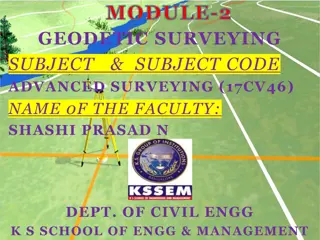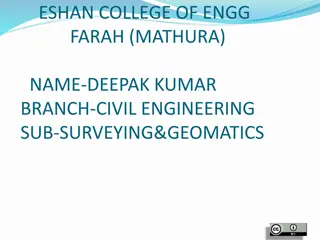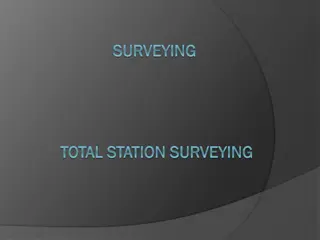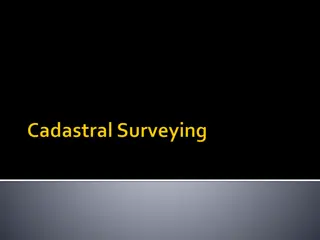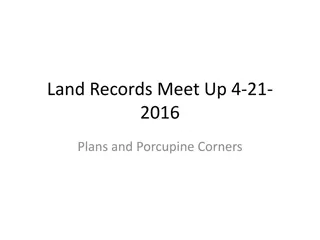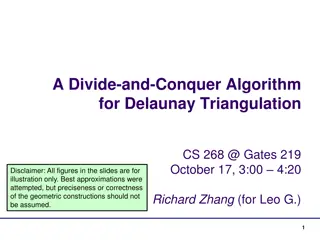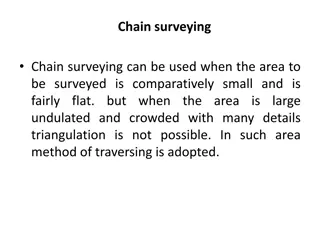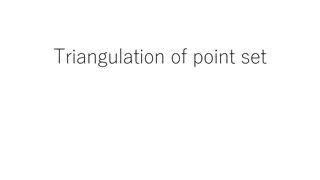Understanding Triangulation Survey in Land Surveying
Triangulation survey is a method used to determine precise coordinates of fixed points in the field, especially in hilly areas. It involves establishing stations at reasonable distances apart to form a framework of triangles covering the entire survey area. Key operations include reconnaissance, erecting signals and towers, measuring baselines, angles, and making necessary computations. Careful selection of ground stations based on visibility, location, and inter-visibility is crucial for accurate results. Triangulation surveys are essential for various applications such as establishing control points for large area surveys and locating engineering projects.
Download Presentation

Please find below an Image/Link to download the presentation.
The content on the website is provided AS IS for your information and personal use only. It may not be sold, licensed, or shared on other websites without obtaining consent from the author. Download presentation by click this link. If you encounter any issues during the download, it is possible that the publisher has removed the file from their server.
E N D
Presentation Transcript
Triangulation Survey Triangulation is a method of determining coordinates of a point fixed in the field to be used as control point for survey work. Triangulation is preferred for hills and undulating areas, since it is easy to establish stations at reasonable distances apart, with inter-visibility. In plane and crowded areas it is not suitable as the inter-visibility of stations is affected. The difficulty is overcome by building towers which is quite expensive. In triangulation, entire area to be surveyed is covered with a framework of triangles. For the triangle, the length of the first line, which is measured precisely is known as Base line.
Operation of Triangulation Survey Steps for executing triangulation project The field work of a triangulation project is carried out in the following well defined operations: 1. Reconnaissance 2. Erection of Signals & Towers 3. 4. Meridian and the Absolute Positions of the Stations 5. Measurement of Baseline Measurement of Horizontal Angles Astronomical Observations Necessary to Determine the True 6. 7. 8. Adjustment of observed Angles Computations of Lengths of each side of each triangle Computations of the Latitude and Longitude of ST
Conditions for selecting ground stations Conditions for selecting ground stations Reconnaissance 1. 2. 3. Examination of the country to be surveyed. Selection of most favorable sides for base lines Selection of suitable positions of stations 2. Selection of Station: The selection of station is based upon the following consideration. 1. highest commanding positions such as top of hills or mountains is selected. 2. They should form well shaped triangles (angles > 30 deg) 3. They should be easily accessible The stations should be clearly visible from each other. For this purpose 4. 5. They should be useful for detail survey Thy should be so fixed that the length of sight is not too short or too long
Conditions for selecting ground stations Conditions for selecting ground stations 3. Inter-visibility and Heights of Stations: For inter-visibility of two stations they should be fixed on highest available ground. Such as mountain peaks rides or top of hills when the distance b/t the two stations is great and the difference in elevation b/t them is small then it is necessary to raise both the instrument and signal to overcome the curvature of the earth and to clear all the intervening obstruction. The height of both the instrument and signal above the ground depends upon. 1. 2. 3. Distance between the stations. Relative elevations of stations. The profile of intervening ground.
Applications of Triangulation Survey Following are some applications of triangulation survey: * Establishing accurately located control points for plane and geodetic surveys of large areas. * Establishing accurately located control points in connection with aerial surveying * Accurate location of engineering projects such as Centre lines, terminal points and shafts for long tunnels, and Centre lines and abutments for long span bridges. Triangulation Systems A system consisting of triangulation stations connected by a chain of triangles. The complete fig is called triangulation system or triangulation figure. The most common type of figures used in a triangulation system are Triangles Quadrilaterals Polygons
Triangulation Systems Triangles System: simple, economical but least accurate system. Triangles 1. A chain of triangles is very rapid and economical when a narrow strip of terrain is to be surveyed. 2. Angles less than 30o or more than 120o are not permitted 3. For well-conditioned triangles, angles should not be less than 30o or more than 120o.
Triangulation Systems Quadrilaterals System: most accurate system as the number of checks are more. Quadrilaterals 1.These afford an excellent system since the various combinations of sides and angles can be used to compute the lengths of required sides, and checks can be made frequently 2.The best quadrilateral is square. A quadrilateral with both diagonals having no station at their intersection is usually employed. 3.This is best suited for hilly areas.
Triangulation Systems Triangulation Systems Polygons: Accurate since more checks are there. Polygons 1. When areas that are very wide in proportion to their lengths are to be surveyed then pentagonal or hexagonal figures may be economical. 2. These may or may not have a central station.
Intersection Method Intersection Method The triangle is the simplest unit of the triangulation net. We start with a Base Line with known azimuth and precise length. All angles of the triangle are measured and should be adjusted to sum to 180. At least on end point of the base line should have known ground coordinates: E and N or X and Y.
Intersection Solution Intersection Solution Given Coordinates of A and B; Observed angles and : To compute coordinates of point P: Xpand YP Y, N P (XP, YP)? B A X, E
Intersection Solution Intersection Solution 1- Calculate departure and latitude of line AB XAB= XB XA; YAB= YB YA, which are necessary for determining bearing AZAB( AB) and the length DABof side AB: 1.1 DAB= ( XAB2+ YAB2) 1.2 Azimuth of AB = AZABor ( AB) = arctan ( XAB/ YAB); 2-Use the Sine rule to calculate the length DAPfrom triangle ABP: DAP/ sin = DAB / sin ( + ) DAP= DAB sin / sin ( + ) 3- Calculate the bearing (azimuth) of the side AP: AZAP= AZAB+ , 4- Calculate Northing and Easting differences (departure and latitudes) using the length and bearing of the side AP: XAP= DAP cos AZAP; YAP= DAP sin AZAP 5-The final coordinates of point P: XP= XA+ XAPand YP= YA+ YAP
Check Intersection Solution Check Intersection Solution Calculation of coordinates of P can be carried out using length and azimuth of BP and coordinates of B to check the previous results: 1- Length of side BP: DBP/ sin = DAB/ sin( + ) DBP=DAB sin / sin( + ) 2- Bearing or Azimuth of side BP: AZBP= AZBA ; AZBA = AZAB 180o 3- North and East differences using the length and bearing of the side BP: XBP= DBP cos AZBP YBP= DBP sin AZBP 4- The final coordinates of point P: XP= XB+ XBPand YP= YB+ YBP This should be exactly equal to coordinates of P computed from station A
Intersection Formula The following formulae are called intersection formula, used to calculate coordinates of P by directly substituting the given and observed data: NP= {EA EB + NA cot + NB cot } / [cot + cot ] EP = {NB- NA + EAcot + EBcot } / [cot + cot ] NOTE: Direct substitution should be done when observing A and B from P should be seen clockwise direction. This means standing at P observing A, you have to turn clockwise to observe B. Example: A and B are ground control points of coordinates: A(200.00, 400.00)m and B(500.00, 600.00)m. Angles observed at A and B towards station P (almost east of A) are 65o00 00 and 67o00 00 respectively, compute coordinates of P.
Resection Solution Resection Solution When an unknown coordinates station (P) is occupied by an angle observation instrument and directions to three control points are observed from this station, the procedure to calculate coordinates of this point is known as Resection solution or three points problem. If coordinates of A, B and C are known Directions PA, PB and PC are observed to determine angles and Required are coordinates of P Many solutions are available One solution will be discussed here. The key for this solution is to calculate angles x (CAP) and y (PBC)
Resection Solution Resection Solution * First step: Using coordinates of A, B and C solve triangle ABC (Lengths of sides and angles of the triangle: AB, BC, CA, <ABC, <BCA and <CAB) Using Pythagoras theory for sides and cosine rule for angles * To compute unknown angles x and y, two equations are needed: Angle equation and side equation First equation, Angle Equation Denoting the (unknown) angles CAP as x and CBP as y, angle ACP = C, can be determined from given coordinates of control points. From the angles of the quadrilateral PACB, x + y = 2 C = k1 k1= 2 C is thus a known value, and we can write equation (1) as: y = k1 x . (1)
Resection Solution Resection Solution Second Equation: Side Equation Applying the law of sine in triangles PAC and PCB we can express PC in two different ways: From the above relation: sin x / sin y = BC sin / AC sin = k2 (2) K2 = BC sin / AC sin is also a known value. With this substitution the equation can be written: sin x = k2 sin y We now need to solve these two equations in two unknowns. Once x and y are known the various triangles can be solved straight forward and intersection method can be used to determine the position of P.
Resection Solution Resection Solution Solution of the two equations to give x and y: 1- compute constants k1 and k2 2- Substituting (1) in (2): sin x = k2sin (k1 x) sin x = k2[ sin k1cos x - cos k1sin x ] Dividing both sides by cos x, tan x = k2[sin k1- cos k1tan x], hence: tan x [1 + k2cos k1] = k2sin k1 tan x =k2sin k1/[1 + k2cos k1]; 3- Substitute values of k1 and k2 to calculate x and y: x = tan-1{k2sin k1/[1 + k2cos k1]} y = k1 x 4- Check the solution: In ACP, <ACP = C1; In BCP, <BCP = C2; C1 + C2 = C, already calculated in ABC; also 180 ( +C1) = x and 180 ( + C2
Resection Solution Resection Solution 5- In APC, coordinates of A and C are known; angles x and C1 are known, use intersection solution to solve for coordinates of P 6- Check: In BPC, coordinates of B and C are known; angles y and C2 are known, use intersection solution to solve for coordinates of P Example: A theodolite was adjusted at station P and angles APC and CPB were observed and recorded as: 109.3045oand 115.0520orespectively. Ground coordinates of stations A, B and C are respectively given as: A(1000.00, 5300.00); B(3100.00, 5000.00); C(2200.00, 6300.00)m Compute the coordinates of station P. C P(E, N)? y P x A B
Trilateration Survey Trilateration Survey * With the introduction of EDM it became more practical to measure lengths of sides of triangles in triangulation nets rather than angles. * The process will be faster and give accurate results. This is called Trilateration. * For a triangle ABC where AB is the base line (with length and azimuth precisely known) sides BC and AC will be measured using EDM. * Angles of triangle can be calculated using cosine rule. * Intersection solution can be applied to Compute coordinates of station C.
Trilateration Survey Trilateration Survey * Having calculated coordinates of C, length of BC can be computed and used as base line for next triangle BCD. * For a neighboring triangle BCD, sides BD and CD are measured. * Angles of triangle BCD can be computed using cosine rule. * Again applying intersection solution will allow computing coordinates of D. Example Trilateration was carried out to observe sides of triangulation net ABQP, including Base line AB whose azimuth was known to be 60o00 00 . Observed sides lengths are: AB = 360.00m; BP = 440.00m BQ = 320.00m; QP = 480.00m; PA = 450.00m Assuming control point A(100.00; 250.00)m, compute: coordinates of B, C and D.


